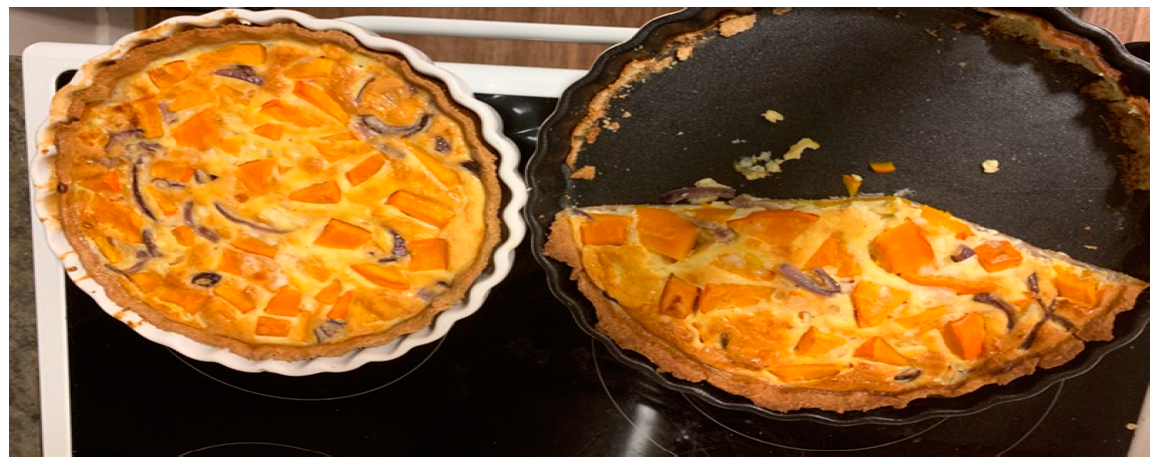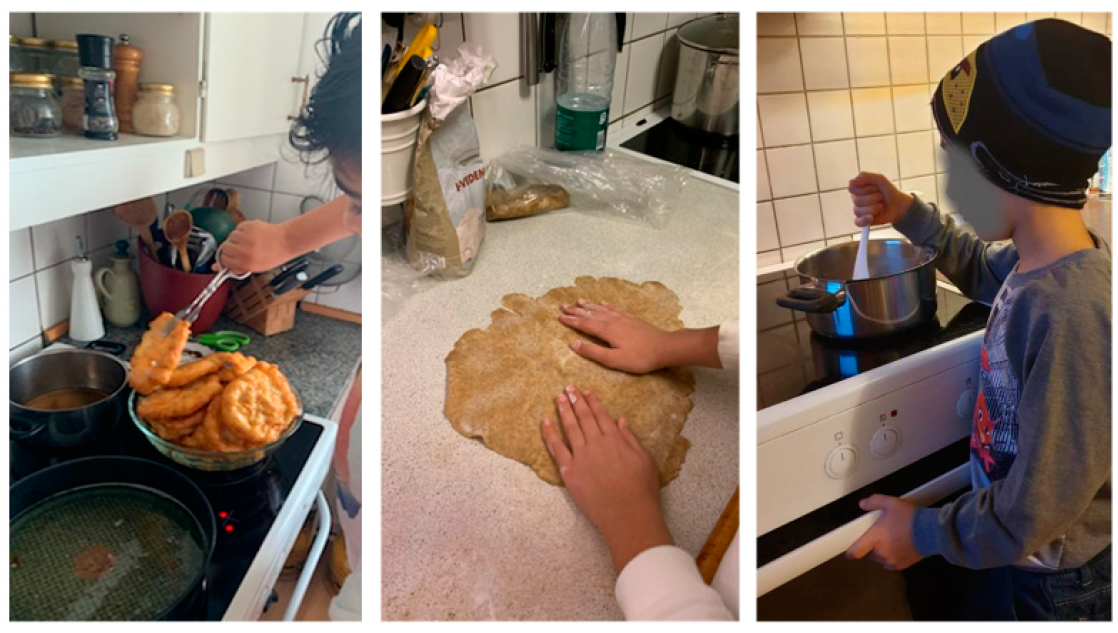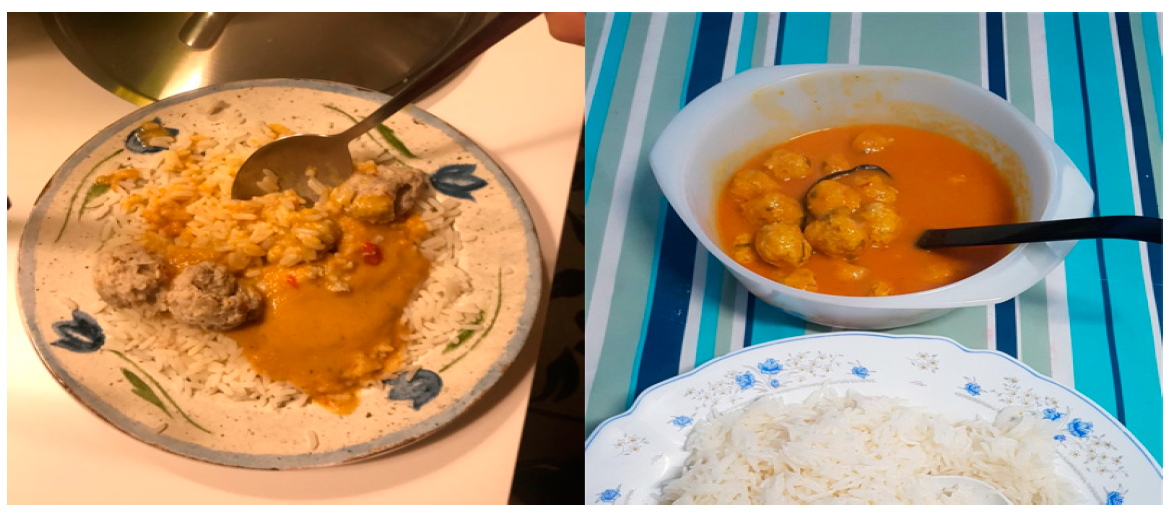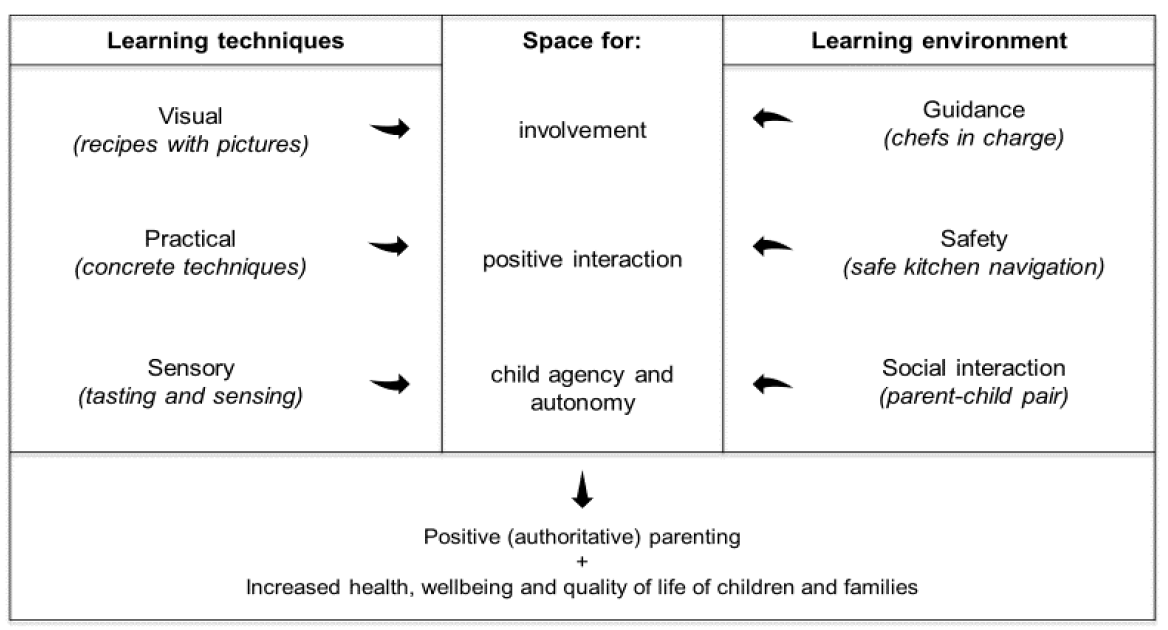Supporting Positive Parenting and Promoting Healthy Living through Family Cooking Classes
Abstract
1. Introduction
Parenting Style and Positive Parenting
2. Materials and Methods
2.1. Setting and Participants
2.2. Methods
2.2.1. The Participant Driven Photo Elicitation (PDPE) Approach
2.2.2. Observations and Evaluation Workshop
2.3. Ethics and Informed Consent
2.4. Analytical Process
3. Results
3.1. Cooking Together—Motivation and Experienced Outcomes
I think my mom and I have been closer than normal. Usually, the kids just play and watch TV, and now I’m allowed to join in(focus group with children).
We are a bit closer, right? [addressing her daughter] And we got to know each other better—you know, you get to know each other when you do nice things together, you connect. And then you see what your daughter can do. I mean, it’s true, it adds something different(mother, interview family 8).
3.2. Learning Techniques Facilitating Parent–Child Interaction
3.2.1. Visual Communication (Recipes with Pictures)
They gave us recipes with pictures of everything we needed to use. That was nice. We kept those [the recipes, ed.] and now we can talk about which ingredients go into the meal and we taste it and talk about what is in our food(mother, interview family 4).
Daughter: I got to do a lot of chopping and a lot of other things …
Mother: There was especially one recipe you did on your own—I said ‘you do that’…
Daughter: Hummus!
Mother: She did it completely on her own and she was the one asking the chefs for help. I said, ‘go and ask them’. And she did—she made it—and in the end she said “mom, taste this”. And it was good!(mother and daughter, interview family 8).
3.2.2. Practical Learning (Cooking Techniques)
A mother and daughter are chopping vegetables. One of the chefs walks by, “can I show you a small trick with the carrots?”, she asks. She demonstrates a specific way of holding and slicing the carrot, and both mother and daughter pay close attention. The ambiance is nice and calm between mother and daughter—they laugh together. They both seem eager to learn when the chef gives them further details on small tricks in the kitchen and they try—together—to copy the chef’s way of holding the knife and slicing. The chef compliments them both in doing a good job(observational notes, 30 October 2019).
3.2.3. Sensory Learning (Tasting and Sensing)
The boy tastes the sauce he had just made together with his mother, “ahhhh pffff” he shouts and put his hands in front of his mouth. “It tastes horrible! It’s way too salty. Too much soya”. The chef, who had come to assist mother and son, takes a small taste. “Well, it is a bit salty… but you’re quite an actor, huh!” They all laugh, and the chef suggests something sweet, for example a bit of honey, he helps mother and son taste their way to a nice sauce(observational notes, 13 November 2019).
3.3. Context-Sensitive Learning Environment
3.3.1. Guidance
They [the chefs] were the ones who initiated things—they had divided all the task with numbers and had things quite well under control; it was ‘here we do the spices’, ‘here we do this’ and ‘here we do that’. We were not thrown into something and left all to ourselves. They were there all the time(mother, interview family 2).
The chef moves on to demonstrate how the spaghetti maker works. Today we are making the spaghetti from vegetables—carrots and courgettes. The chef asks everyone to pay attention, but he is interrupted by a girl: “I want to try! Can I?” she asks eagerly. “Yes, together with an adult” the chef answers. He says that a machine like this can be used only together with an adult, and then he continues to explain and demonstrate exactly what the adult must do and how the child can assist(observational notes, 27 November 2019).
3.3.2. Safety
I always used to say ‘careful with your fingers! Watch out for the big knife! You must use the small knife!’ Even though he said ‘mom, I know about this—we do it at school’. But now I can actually believe it, because I saw it (mother and son laugh)(mother and son, interview family 7).
3.3.3. Social Interactions
We got to know each other and learned how to work together. That was nice! We—the mothers—we allowed a space for our children in the kitchen(mother, interview family 8).
3.4. Transferring the Positive Parent–Child Dynamics to the Home Environment
I witnessed completely new sides of her. How she relates to others and takes on an assignment. She’s helpful. I see her in a different context than when we sit here, and as we know each other in our own little den. It’s completely different to see them relating to other people, how they manage their tasks(mother, interview family 2).
Before, it was kind of an adult world … we get up, get breakfast, get ready and go! But now, sometimes if they get up a bit earlier than usual, I realize that we have time and I invite them into the kitchen. Also, in the evening, when I cook dinner—for example with rice and vine leaves—and I let them stir the rice or something. I don’t know, but it [ed: participation in cooking classes] has affected us in a way where I invite them more into the kitchen, because I have seen that they can do it(mother, family 4).
4. Discussion
4.1. Linking Family Cooking, Health Promotion and Positive Parenting
4.2. Applying Participatory Methods in Working with Families
4.3. Limitations
5. Conclusions
Author Contributions
Funding
Institutional Review Board Statement
Informed Consent Statement
Data Availability Statement
Acknowledgments
Conflicts of Interest
References
- Dahlgren, G.; Whitehead, M. Policies and Strategies to Promote Social Equity in Health. Background Document to WHO—Strategy Paper for Europe; Arbetsrapport; Institute for Futures Studies: Stockholm, Sweden, 1991. [Google Scholar]
- CSDH. Closing the Gap in a Generation: Health Equity through Action on the Social Determinants of Health: Final Report of the Commission on Social Determinants of Health; World Health Organization: Geneva, Switzerland, 2008. [Google Scholar]
- WHO. The Ottawa Charter for Health Promotion. In Ottawa; WHO: Geneva, Switzerland, 1986. [Google Scholar]
- Soubhi, H.; Potvin, L. Homes and families as health promotion settings. In Settings for Health Promotion: Linking Theory and Practice; Poland, B.D., Green, L.W., Rootman, I., Eds.; SAGE Publications, Ltd.: Thousand Oaks, CA, USA, 2000. [Google Scholar]
- Barnes, M.D.; Hanson, C.L.; Novilla, L.B.; Magnusson, B.M.; Crandall, A.C.; Bradford, G. Family-Centered Health Promotion: Perspectives for Engaging Families and Achieving Better Health Outcomes. Inquiry 2020, 57, 1–6. [Google Scholar]
- Davies, L.M.; Janta, B.; Gardner, F. Positive Parenting Interventions: Empowering Parents with Positive Parenting Techniques for Lifelong Health and Well-Being; European Platform for Investing in Children (EPIC): Luxembourg, 2019. [Google Scholar]
- Nievar, M.A.; Moske, A.K.; Johnson, D.J.; Chen, Q. Parenting Practices in Preschool Leading to Later Cognitive Competence: A Family Stress Model. Early Educ. Dev. 2014, 25, 318–337. [Google Scholar] [CrossRef]
- Pinquart, M. Associations of parenting styles and dimensions with academic achievement in children and adolescents: A meta-analysis. Educ. Psychol. Rev. 2016, 28, 475–493. [Google Scholar] [CrossRef]
- Baumrind, D. The influence of parenting style on adolescent competence and substance use. J. Early Adolesc. 1991, 11, 56–95. [Google Scholar] [CrossRef]
- Pinquart, M. Associations of parenting dimensions and styles with externalizing problems of children and adolescents: An updated meta-analysis. Dev. Psychol. 2017, 53, 873–932. [Google Scholar] [CrossRef] [PubMed]
- Leung, C.; Lo, S.K.; Tsang, S.; Chan, R.; Kung, E. The relationship between family dining practices, parenting style and family functioning and child learning. Int. J. Disabil. Hum. Dev. 2016, 15, 267–276. [Google Scholar] [CrossRef][Green Version]
- Demakakos, P.; Pillas, D.; Marmot, M.; Steptoe, A. Parenting style in childhood and mortality risk at older ages: A longitudinal cohort study. Br. J. Psychiatry 2016, 209, 135–141. [Google Scholar] [CrossRef] [PubMed]
- Davids, E.L.; Roman, N.V.; Leach, L. The link between parenting approaches and health behavior: A systematic review. J. Hum. Behav. Soc. Environ. 2017, 27, 589–608. [Google Scholar] [CrossRef]
- Nicholls, L.; Lewis, A.J.; Petersen, S.; Swinburn, B.; Moodie, M.; Millar, L. Parental encouragement of healthy behaviors: Adolescent weight status and health-related quality of life. BMC Public Health 2014, 14, 369. [Google Scholar] [CrossRef] [PubMed]
- Philips, N.; Sioen, I.; Michels, N.; Sleddens, E.; De Henauw, S. The influence of parenting style on health related behavior of children: Findings from the ChiBS study. Int. J. Behav. Nutr. Phys. Act. 2014, 11, 95. [Google Scholar] [CrossRef]
- Ray, C.; Kalland, M.; Lehto, R.; Roos, E. Does parental warmth and responsiveness moderate the associations between parenting practices and children’s health-related behaviors? J. Nutr. Educ. Behav. 2013, 45, 602–610. [Google Scholar] [CrossRef]
- Rew, L.; Arheart, K.L.; Thompson, S.; Johnson, K. Predictors of adolescents’ health-promoting behaviors guided by primary socialization theory. J. Spec. Pediatr. Nurs. 2013, 18, 277–288. [Google Scholar] [CrossRef]
- Kuczynski, L. Beyond bidirectionality: Bilateral conceptual frameworks for understanding dynamics in parent-child relations. In Handbook of Dynamics in Parent-Child Relations; Kuczynski, L., Ed.; SAGE Publications, Inc.: Thousand Oaks, CA, USA, 2003; pp. 3–24. [Google Scholar]
- O’Conner, T.; Scott, S. Parenting and Outcomes for Children; Kigs College: London, UK, 2007. [Google Scholar]
- Huh, D.; Tristan, J.; Wade, E.; Stice, E. Does Problem Behavior Elicit Poor Parenting? A Prospective Study of Adolescent Girls. J. Adolesc. Res. 2006, 21, 185–204. [Google Scholar] [CrossRef]
- Cuellar, J.; Jones, D.J.; Sterrett, E. Examining Parenting in the Neighborhood Context: A Review. J. Child Fam. Stud. 2015, 24, 195–219. [Google Scholar] [CrossRef]
- Akers, D.; Mince, J. Family Growth Center: A Community-Based Social Support Program for Teen Mothers and Their Families. In Model Programs for Adolescent Sexual Health: Evidence-Based HIV, STI, and Pregnancy Prevention Interventions; Benner, T., Ed.; Springer Publishing Co.: New York, NY, USA, 2008; pp. 143–154. [Google Scholar]
- Furlong, M.; McGilloway, S. Challenges and Future Directions in the Evaluation of Parenting Programmes. In Parenting: Challenges, Practices and Cultural Influences; Barberis, P., Petrakis, S., Eds.; Nova Science Pub Inc.: Hauppauge, NY, USA, 2013; pp. 177–188. [Google Scholar]
- Ling, J.; Robbins, L.B.; Wen, F. Interventions to prevent and manage overweight or obesity in preschool children: A systematic review. Int. J. Nurs. Stud. 2016, 53, 270–289. [Google Scholar] [CrossRef]
- Van der Horst, K.; Ferrage, A.; Rytz, A. Involving children in meal preparation. Effects Food intake. Appetite 2014, 79, 18–24. [Google Scholar] [CrossRef]
- Miller, M.E.; Kaesberg, J.L.; Thompson, V.B.; Wyand, R.A. ‘What’s Cooking?’: Qualitative Evaluation of a Head Start Parent-Child Pilot Cooking Program. Health Promot. Pract. 2017, 18, 854–861. [Google Scholar] [CrossRef]
- Baumrind, D. Effects of authoritative parental control on child behavior. Child Dev. 1966, 37, 887–907. [Google Scholar] [CrossRef]
- Maccoby, E.; Martin, J. Socialization in the Context of the Family: Parent–Child Interaction. In Handbook of Child Psychology: Vol 4 Socialization, Personality, and Social Development, 4th ed.; Mussen, P., Hetherington, E., Eds.; Wiley: New York, NY, USA, 1983; pp. 1–101. [Google Scholar]
- Steinberg, L. We know some things: Parent–adolescent relationships in retrospect and prospect. J. Res. Adolesc. 2001, 11, 1–19. [Google Scholar] [CrossRef]
- Aunola, K.; Stattin, H.; Nurmi, J.E. Parenting styles and adolescents’ achievement strategies. J. Adolesc. 2000, 23, 205–222. [Google Scholar] [CrossRef]
- Radziszewska, B.; Richardson, J.L.; Dent, C.W.; Flay, B.R. Parenting style and adolescent depressive symptoms, smoking, and academic achievement: Ethnic, gender, and SES differences. J. Behav. Med. 1996, 19, 289–305. [Google Scholar] [CrossRef]
- Rhee, K. Childhood Overweight and the Relationship between Parent Behaviors, Parenting Style, and Family Functioning. ANNALS Am. Acad. Polit. Social Sci. 2008, 615, 11–37. [Google Scholar] [CrossRef]
- Yap, M.B.H.; Pilkington, P.D.; Ryan, S.M.; Jorm, A.F. Parental factors associated with depression and anxiety in young people: A systematic review and meta-analysis. J. Affect. Disord. 2014, 156, 8–23. [Google Scholar] [CrossRef]
- Chen, Y.; Haines, J.; Charlton, B.M.; VanderWeele, T.J. Positive parenting improves multiple aspects of health and well-being in young adulthood. Nat. Hum. Behav. 2019, 3, 684–691. [Google Scholar] [CrossRef]
- Tørslev, M.K.; Andersen, P.T.; Nielsen, A.V.; Petri, M.; Termansen, T.; Vardinghus-Nielsen, H.; Varming, A.; Bloch, P. Tingbjerg Changing Diabetes: A Supersetting Initiative to Promote Healthy Living and Prevent type 2 Diabetes Among People Living in an Ethnically and Socio-Economically Diverse Neighbourhood in Copenhagen, Denmark. 2021; in review. [Google Scholar]
- Baird, J.; Jacob, C.; Barker, M.; Fall, C.H.D.; Hanson, M.; Harvey, N.C.; Cooper, C. Developmental Origins of Health and Disease: A Lifecourse Approach to the Prevention of Non-Communicable Diseases. In Healthcare; MDPI: Basel, Switzerland, 2017; Volume 5. [Google Scholar]
- Brown, T.; Wyatt, J. Design Thinking for Social Innovation. Dev. Outreach 2010, 12, 29–43. [Google Scholar] [CrossRef]
- Hello Kitchen. Hello Kitchen [Internet]. Available online: https://hellokitchen.dk/ (accessed on 27 April 2021).
- Harper, D. Visual Sociology; Routledge: London, UK, 2012. [Google Scholar]
- Carlsson, B. Depicting Experiences. Scand. J. Educ. Res. 2001, 45, 125–143. [Google Scholar] [CrossRef]
- Gold, S.J. Using photography in studies of immigrant communities. Am. Behav. Sci. 2004, 47, 1551–1572. [Google Scholar] [CrossRef]
- Harper, D. Talking about pictures: A case for photo elicitation. Vis. Stud. 2002, 17, 13–26. [Google Scholar] [CrossRef]
- Christensen, P.; James, A. Research with Children: Perspectives and Practices, 3rd ed.; Routledge: New York, NY, USA, 2017. [Google Scholar]
- Castleden, H.; Garvin, T.; First Nation, H. Modifying Photovoice for community-based participatory Indigenous research. Soc. Sci. Med. 2008, 66, 1393–1405. [Google Scholar] [CrossRef]
- Coffey, A.; Atkinson, P. Making Sense of Qualitative Data: Complementary Research Strategies; SAGE: London, UK, 1996. [Google Scholar]
- Mason, J. Qualitative Researching; SAGE: London, UK, 2006. [Google Scholar]
- Darling, N.; Steinberg, L. Parenting style as context: An integrative model. Psychol. Bull. 1993, 113, 487–496. [Google Scholar] [CrossRef]
- Corsaro, W. The Sociology of Childhood, 5th ed.; SAGE Publications, Inc.: Los Angeles, CA, USA, 2017. [Google Scholar]
- Maccoby, E. The Uniqueness of the Parent-Child Relationship. In Relationships as Developmental Contexts; Collins, W., Laursen, B., Eds.; Erlbaum: Mahwah, NJ, USA, 2000; pp. 157–175. [Google Scholar]
- Quelly, S.B. Helping with Meal Preparation and Children’s Dietary Intake: A Literature Review. J. School Nurs. Off. Publ. Natl. Assoc. Sch. Nurses 2019, 35, 51–60. [Google Scholar] [CrossRef] [PubMed]
- Vollmer, R.L.; Baietto, J. Practices and preferences: Exploring the relationships between food-related parenting practices and child food preferences for high fat and/or sugar foods, fruits, and vegetables. Appetite 2017, 113, 134–140. [Google Scholar] [CrossRef] [PubMed]
- Chu, Y.L.; Farmer, A.; Fung, C.; Kuhle, S.; Storey, K.E.; Veugelers, P.J. Involvement in home meal preparation is associated with food preference and self-efficacy among Canadian children. Public Health Nutr. 2013, 16, 108–112. [Google Scholar] [CrossRef] [PubMed]
- Skafida, V. The family meal panacea: Exploring how different aspects of family meal occurrence, meal habits and meal enjoyment relate to young children’s diets. Sociol. Health Illn. 2013, 35, 906–923. [Google Scholar] [CrossRef]
- Woodruff, S.J.; Kirby, A.R. The associations among family meal frequency, food preparation frequency, self-efficacy for cooking, and food preparation techniques in children and adolescents. J. Nutr. Educ. Behav. 2013, 45, 296–303. [Google Scholar] [CrossRef]
- Kim, Y. Evaluating an Integrated Nutrition and Parenting Education Program for Preschoolers and Their Parents. J. Ext. 2016, 54, 1–10, ISSN EISSN-1077-5315. [Google Scholar]
- Collier, J., Jr.; Collier, M. Visual Anthropology: Photography as a Research Method (Revised and Expanded); University of New Mexico Press: Albuquerque, NM, USA, 1986. [Google Scholar]
- Guillemin, M.; Drew, S. Questions of process in participant-generated visual methodologies. Vis. Stud. 2010, 25, 175–188. [Google Scholar] [CrossRef]
- Clausen, L.T.; Schmidt, C.; Aagaard-Hansen, J.; Reinbach, H.C.; Toft, U.; Bloch, P. Children as visionary change agents in Danish school health promotion. Health Promot. Int. 2019, 34, e18–e27. [Google Scholar] [CrossRef]
- Berge, J.M.; Mendenhall, T.J.; Doherty, W.J. Using Community-based Participatory Research (CBPR) To Target Health Disparities in Families. Fam. Relat. 2009, 58, 475–488. [Google Scholar] [CrossRef]
- Bloch, P.; Toft, U.; Reinbach, H.C.; Clausen, L.T.; Mikkelsen, B.E.; Poulsen, K.; Jensen, B.B. Revitalizing the setting approach—Supersettings for sustainable impact in community health promotion. Int. J. Behav. Nutr. Phys. Act. 2014, 11, 118. [Google Scholar] [CrossRef]
- Lögdberg, U.; Nilsson, B.; Kostenius, C. Young Migrants’ Experiences and Conditions for Health: A Photovoice Study. SAGE Open 2020, 10, 1–12. [Google Scholar] [CrossRef]




| Time | Activity |
|---|---|
| 16.30 | Arrival |
| 16.40 | Welcome at the table—healthy snack and chat |
| 17.00 | Washing hands and putting on aprons |
| 17.10 | Introduction to the produce and ingredient table—demonstration of tasks |
| 17.30 | Cooking—first part |
| 18.00 | ‘Kitchen break’ with demonstration of tasks |
| 18.15 | Cooking—second part. Setting the table |
| 19.00 | Eating together |
| 19.30 | Cleaning up and dishwashing |
| 20.00 | Goodbye—distributing leftovers |
| Course | Participants | n Photos | |
|---|---|---|---|
| Family 1 | A | Mother, daughter (aged 11 years) | 9 photos |
| Family 2 | A | Mother, daughter (aged 10 years) | 28 photos |
| Family 3 | A | Mother, son (aged 12 years) | 14 photos |
| Family 4 | A | Father/mother, son (aged 8 years) | 16 photos |
| Family 5 | B | Mother, son (aged 11 years) | 19 photos |
| Family 6 | B | Father, son (aged 10 years) | 29 photos |
| Family 7 | A + B | Mother, son (aged 12 years) | 38 photos |
| Family 8 | B | Mother, daughter (aged 10 years) | 16 photos |
| Family 9 | B | Mother, daughter (aged 9 years), son (aged 9 years) | 6 photos |
Publisher’s Note: MDPI stays neutral with regard to jurisdictional claims in published maps and institutional affiliations. |
© 2021 by the authors. Licensee MDPI, Basel, Switzerland. This article is an open access article distributed under the terms and conditions of the Creative Commons Attribution (CC BY) license (https://creativecommons.org/licenses/by/4.0/).
Share and Cite
Tørslev, M.K.; Bjarup Thøgersen, D.; Høstgaard Bonde, A.; Bloch, P.; Varming, A. Supporting Positive Parenting and Promoting Healthy Living through Family Cooking Classes. Int. J. Environ. Res. Public Health 2021, 18, 4709. https://doi.org/10.3390/ijerph18094709
Tørslev MK, Bjarup Thøgersen D, Høstgaard Bonde A, Bloch P, Varming A. Supporting Positive Parenting and Promoting Healthy Living through Family Cooking Classes. International Journal of Environmental Research and Public Health. 2021; 18(9):4709. https://doi.org/10.3390/ijerph18094709
Chicago/Turabian StyleTørslev, Mette Kirstine, Dicte Bjarup Thøgersen, Ane Høstgaard Bonde, Paul Bloch, and Annemarie Varming. 2021. "Supporting Positive Parenting and Promoting Healthy Living through Family Cooking Classes" International Journal of Environmental Research and Public Health 18, no. 9: 4709. https://doi.org/10.3390/ijerph18094709
APA StyleTørslev, M. K., Bjarup Thøgersen, D., Høstgaard Bonde, A., Bloch, P., & Varming, A. (2021). Supporting Positive Parenting and Promoting Healthy Living through Family Cooking Classes. International Journal of Environmental Research and Public Health, 18(9), 4709. https://doi.org/10.3390/ijerph18094709







